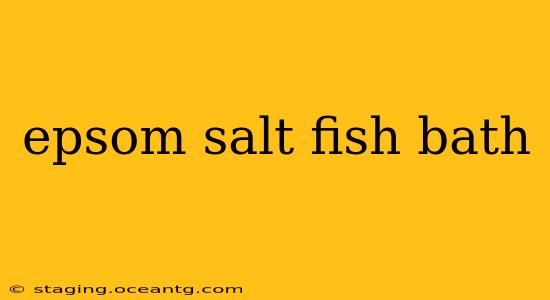Epsom salt fish baths have gained popularity among aquarium enthusiasts as a potential treatment for various fish ailments. While not a miracle cure, Epsom salts can offer several benefits when used correctly. This comprehensive guide delves into the uses, methods, and crucial precautions of using Epsom salts in a fish bath. We'll explore the science behind its effects and answer common questions surrounding this practice.
What are the benefits of an Epsom salt fish bath?
Epsom salt, chemically known as magnesium sulfate, can provide several benefits in a fish bath, primarily due to its osmotic properties and the role of magnesium in fish physiology. These benefits include:
-
Osmotic Regulation: Epsom salts can help regulate the osmotic balance in fish, particularly beneficial for fish suffering from dropsy or other fluid retention issues. By drawing excess fluid out of the fish's tissues, it can alleviate swelling and discomfort. However, it's crucial to use the correct concentration to avoid further stressing the fish.
-
Stress Relief: The magnesium in Epsom salt is known to have a calming effect. In stressful situations like transport or disease, a diluted Epsom salt bath can help reduce the stress on the fish, allowing them to recover faster.
-
Wound Healing: Some believe Epsom salts can promote wound healing in minor external injuries. The magnesium may help to reduce inflammation and encourage faster tissue regeneration. This is anecdotal and further scientific research is needed to validate this claim.
-
Parasite Treatment (Limited): While not a primary treatment, a diluted Epsom salt bath can sometimes help in dealing with external parasites, particularly if combined with other treatments. However, it's crucial to understand that this is not a substitute for proper parasite medication.
How do I perform an Epsom salt fish bath?
Performing a fish bath correctly is crucial to avoid harming your fish. Follow these steps precisely:
-
Prepare the Bath: Use a separate container, not the main aquarium. A clean plastic container is ideal. The container should be large enough to comfortably hold your fish without overcrowding.
-
Prepare the Solution: Dissolve Epsom salt in dechlorinated water. The concentration is critical. A general guideline is 1 teaspoon of Epsom salt per gallon of water. However, this can vary depending on the fish species and its condition. For severely ill fish, consult a veterinarian specializing in aquatic animals.
-
Introduce the Fish: Gently net the fish and place it into the Epsom salt bath. Never directly transfer the fish from the aquarium to the bath. Allow the fish to gradually acclimate to the temperature and salinity changes.
-
Monitor the Fish: Observe the fish closely for any signs of distress (rapid gill movement, erratic swimming, etc.). If any signs of distress occur, immediately return the fish to the main aquarium.
-
Duration: A typical bath lasts for 15-20 minutes. Never exceed 30 minutes.
-
Post-Bath Care: After the bath, gently net the fish and return it to the main aquarium. Monitor the fish closely for the next 24-48 hours for any changes in its behavior or condition.
What are the risks of using Epsom salt fish baths?
While generally safe when used correctly, Epsom salt baths carry certain risks:
-
Osmotic Shock: Using too high a concentration of Epsom salt can lead to osmotic shock, potentially killing the fish. Always adhere to recommended concentrations.
-
Stress: The process itself can be stressful for the fish. Minimize handling and ensure the bath is done efficiently.
-
Incompatible Medications: Epsom salt can interact negatively with some medications. Consult with an aquatic veterinarian before using Epsom salt if your fish is already undergoing treatment.
Can I use Epsom salt for all fish?
No, Epsom salt baths are not suitable for all fish species. Some fish species are more sensitive than others to changes in salinity. Research your specific fish species to determine its suitability for Epsom salt baths. It's best to err on the side of caution and avoid using Epsom salts if you are unsure.
What concentration of Epsom salt should I use for my fish bath?
The concentration of Epsom salt should always be low, typically 1 teaspoon per gallon of water. Higher concentrations can be incredibly harmful. Always prioritize a diluted solution. Never assume that more is better. This is where consulting a specialist veterinarian becomes paramount.
Is an Epsom salt bath a cure-all for fish diseases?
Absolutely not. An Epsom salt bath is a supportive treatment, not a cure. If your fish is exhibiting signs of illness, consult an aquatic veterinarian for a proper diagnosis and treatment plan. Using Epsom salts alone is often inadequate to resolve underlying disease processes.
When should I NOT use an Epsom salt bath?
Avoid using Epsom salt baths if:
- You are unsure about the correct concentration for your fish species.
- Your fish shows severe symptoms of disease.
- Your fish is already undergoing medication.
- You are uncertain about the cause of your fish's illness.
Remember, prevention is key. Maintaining a healthy aquarium environment through proper water parameters, responsible feeding, and regular maintenance is crucial for preventing many fish diseases. An Epsom salt bath should be considered only as a supplementary treatment under the guidance of a professional.
